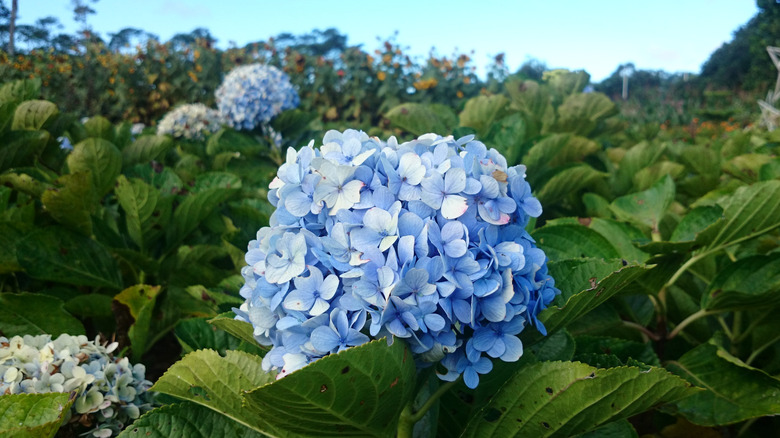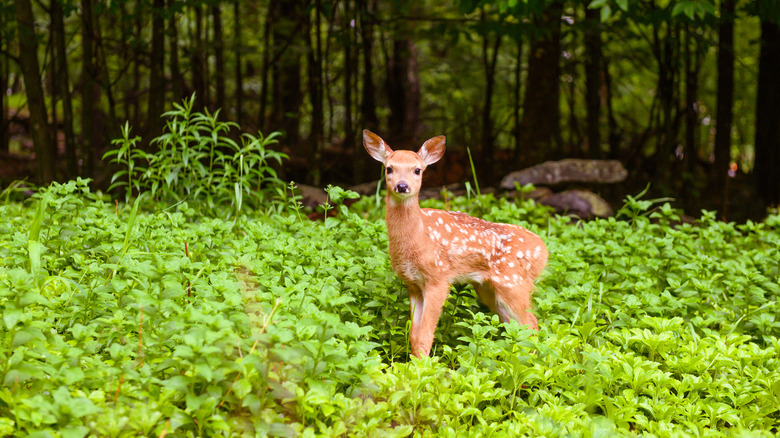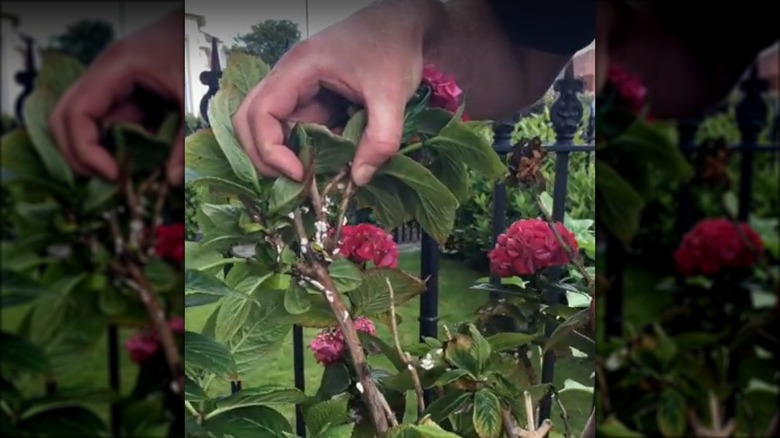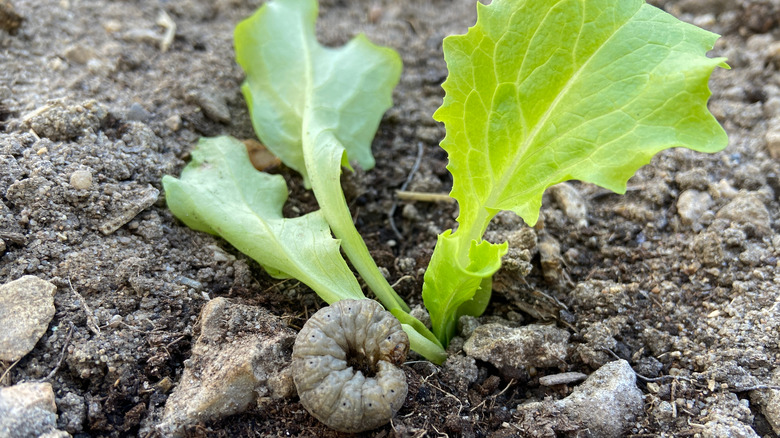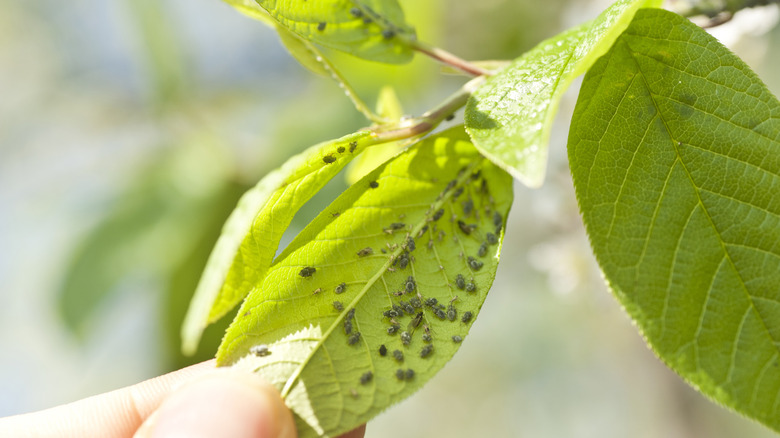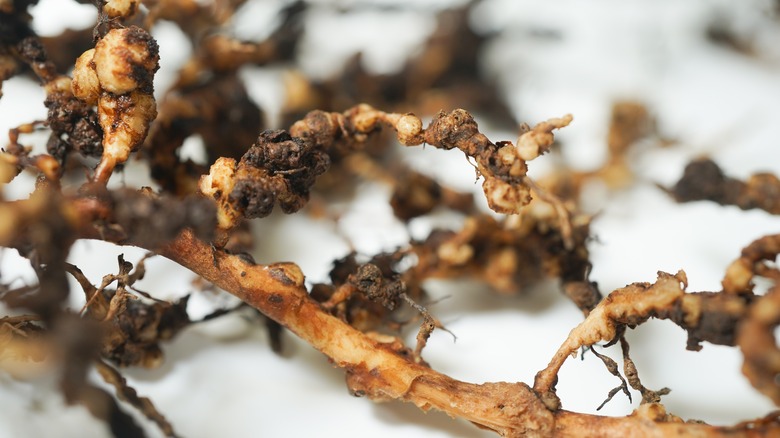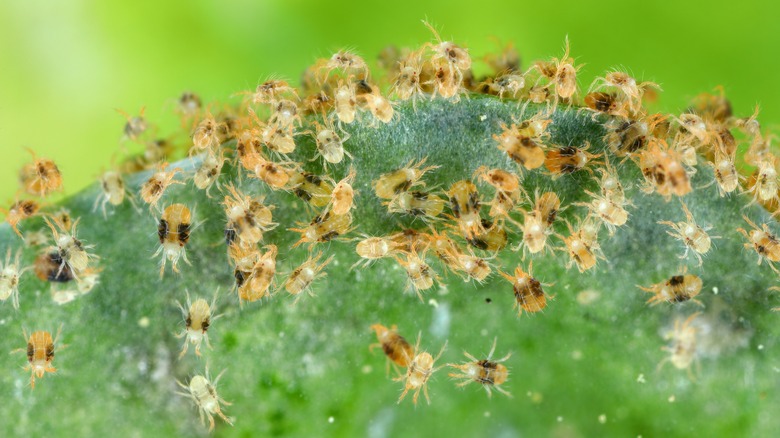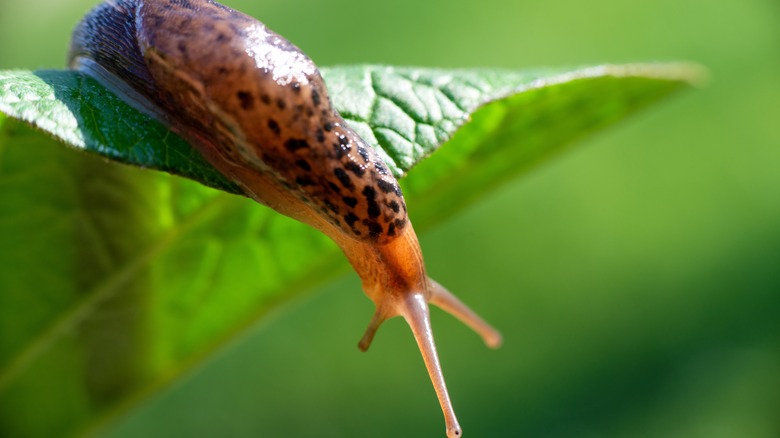7 Pests That Will Destroy Your Hydrangeas (And How To Get Rid Of Them)
Hydrangeas bushes and flowers have such full and gorgeous blooms. The beautiful blue, pink, purple, and other colors can really add beauty to the outside (or inside) of your home. However, when pests find your hydrangeas, they can do some serious damage. All of a sudden, those gorgeous blooms are half-eaten, or even completely missing. The once green leaves are now wilted and turning brown.
If this sounds all too familiar, then you already understand the frustration of dealing with a pest infestation on or near your pretty flowers. Because there are several different pests that can damage this plant, it is important to understand what is causing the problem so you can choose the best course of action. Fortunately for you, the next few sections will help you do just that. We'll take a closer look at different animals and insects that can destroy hydrangeas, learn about the type of damage they can inflict, and explore exactly what you should do to keep them from causing any more harm to your beautiful blooms.
Deer like munching on hydrangeas
If you want to be able to enjoy hydrangeas in your flower beds, then deer are one of the pests you'll need to be prepared for. Deer enjoy munching on hydrangeas, particularly the younger leaves of newer plants. In addition to their more tender leaves, deer also enjoy the flower buds, which are precisely what you'll want them to stay away from so that you can enjoy the beautiful blooms of the flowers.
There are a few varieties of hydrangeas that fare better against deer, though none are considered deer resistant. For example, the leaves of the climbing hydrangea varieties end up too high for deer to reach, but they may still chomp on the leaves towards the bottom. If you want to make sure that bucks, does, and fawns don't make a meal out of your plants, there are some things you can do.
One idea is to use chicken wire to build a protective cage around the flowers, especially when they are just starting to grow. The deer won't be able to eat through the wire, and will move on to somewhere else to find food. Another option is to make the hydrangeas, and your garden beds as a whole, less appealing to the deer. To keep deer out of your yard, you could use a commercial deer repellent spray or try placing some Irish Spring soap around the plants (the deer don't like the way the soap smells and will stay away).
Scale can infest hydrangea leaves
Unfortunately, scale can also plaque hydrangeas. These tiny pests — which may be one of over 8,000 different species — suck the sap from the stems and leaves of hydrangea. If you've ever seen scale before, then you know the pests look similar to some plant diseases. Each insect is very tiny, and, because they cluster in groups, they may look like lots of little bumps all over the leaves or stems of your beautiful plants. But, they're really insects, not a disease. So, the way you work to remediate the problem will be important.
To clear up a scale infestation, there are a few things you'll need to do. Start by pruning branches and leaves where there are multiple insects. Either burn these clippings or seal them tightly in a bag to prevent a new infestation from occurring somewhere else. If there are only a few insects present on the plant, or on certain portions of it, you can treat these sections by spraying a mixture of rubbing alcohol and water (1:7 ratio) to kill the pests. You'll want to continue spraying any affected plants every few days until you no longer see any evidence of an infestation. Insecticidal soap can also be used to kill scale, but note that it will only be effective if the pests are still in the larva stage. Once they have attached themselves to the plants and have a harder shell, they are more resistant to these kinds of products.
Cutworms can kill new hydrangea plants
The name cutworm tells you almost everything you need to know about these pests that can destroy your hydrangeas. Cutworms are not really worms. They are actually caterpillars that will be turning into Noctuid moths. When in the larva stage, they stay underground for most of the day, coming up to the surface of the soil at nighttime. Once they come up, they look to eat, and to do so, will wrap their body around plant stems, such as those from hydrangeas. They stay tightly wrapped, eating the stem, which eventually causes the entire plant to be "cut" off at the base. If you walk out to your garden one day to find nubs of stems sticking through the soil, then you can typically blame cutworms.
Act quickly because you'll have much better luck getting rid of them before they have grown into larger caterpillars. You can verify their presence by inspecting the area around your hydrangeas in the evening. Move your hands through the soil and look for any pests that curl up when they get disturbed by the movement of your hand. Hand-pick cutworms you encounter. Then, add more dry soil around the perimeter of your garden to reduce the likelihood that the cutworms will make themselves at home. Keeping the garden free of weeds can also help keep them away, as the weeds are another food source. For future plantings, it is a good idea to till the soil before you add any new bulbs or plants. Doing so will pull the cutworms up to the surface so that you can remove them.
Aphids can dehyrate hydrangeas by sucking their sap
Aphids are another tiny bug that can spell big trouble for your hydrangeas. Like scale, aphids use their sharp mouths to prick the leaves and stems of hydrangea plants. This allows them to suck the sap out of the plant. Once the liquid is removed from the stems and leaves, they become dehydrated and may wilt or turn yellow. Aphids can be different colors, including green, red, yellow, gray, or black. At most, they are about ⅛-inch long with a pear-shaped body. You're most likely to find several aphids together as they prefer to feed in a group, though it is possible to see a lone one or two occasionally.
To prevent aphids from posing a serious threat to your plants, it is important to take steps to ensure that your hydrangeas are set up for healthy growth. When the flowers are healthier, they'll be more resistant to the threat aphids can pose. You're also more likely to find aphids on younger, more tender leaves, so, when keep an eye out for signs of an infestation, that's the first places you should look. If you notice any aphids, you can prune off affected sections or use insecticidal soap. A few drops of rosemary, thyme, or peppermint essential oils can also help deter aphids and encourage them to find somewhere else to feed.
Root knot nematodes can damage growth systems and interfere with nutrient transfer
As you may be able to guess based on their name, root knot nematodes can damage the roots of hydrangeas and other plants. Despite their microscopic size, these roundworms can pose a serious threat. Chewing on the roots leads to noticeable damage to the parts of the plants that are above the surface. For example, because the leaves can't get all the water and nutrients they need, they may turn yellow or wilt.
There are a few things you can try to prevent root knot nematodes from wreaking havoc on your prized plants. Many of these will require planning ahead to make sure that you're planting the hydrangeas in soil that is not already infested. For example, after spotting an infestation, immediately remove the affected hydrangea and then plow the soil. Plow it again several times over the winter to pull nematodes and their eggs up to the surface, where they will be dried by the wind and sun. When you plant new hydrangeas the following year, add some compost to the soil. The compost can help ensure the plants receive enough moisture to survive. Similarly, you can also try planting marigolds or chrysanthemums around your hydrangea. Known as nematode suppressive plants, these flowers release various compounds into the soil that can interfere with the nematodes' ability to properly mature or produce future generations.
Spider mites can cause hydrangea leaves to wilt or drop
Unlike many other pests, spider mites are not actually insects. As you might be able to guess from their name, they are arachnids and have eight legs, just like other spiders. However, unlike the spiders you likely see around your home, spider mites are much smaller, only about 1/50th of an inch long. They are attracted to plants like hydrangeas and use their mouth organs to suck sap from the underside of the leaves. With an infestation, the leaves of the plant may have a speckled appearance from all the tiny bugs on them. Over time, the leaves of the plant may even fall off from the damage caused by the mites. Like other spiders, these pests even weave webs, which you may notice between the leaves.
If you want to clear up a spider mite infestation on your hydrangeas, start by pulling out the hose and spraying the leaves. A powerful stream of water can help knock the bugs off, kill them, and remove their web. It will be most effective, though, when you're only facing a more minor infestation. You could also consider introducing predatory mites, a natural enemy of spider mites. The predatory mites feed on the pests, helping to clear up your infestation. It is also important to keep your hydrangeas well hydrated. The bugs prefer dry environments, so if you water your flowers more frequently, then you may discourage them from sticking around.
Slugs can eat nearly an entire hydrangea plant
If you walk outside to discover that something has been munching on the leaves or flowers on your hydrangea plants, slugs could be to blame. It is even more likely that slugs are the culprit if you find some trails of slimy mucus around the crime scene. While slugs would rather feast on decaying material or organisms, if these food sources aren't present, they will help themselves to eating the plants in your garden. Slugs can pose a bigger threat to your garden when the weather is cool and damp, as this is when they thrive.
Based on the damage they can cause, you'll want to get rid of slugs as soon as you detect their presence. Start by putting on a pair of gloves and picking up any pests you can see. After picking up any that you spot — the evening or early morning is the best time to try to find them — it is also a good idea to take measures to block their access to your prized plants. Making a barrier from sharp diatomaceous earth, crushed shells, or strips of copper can stop them from gaining access to anything you want to keep them away from. You could also consider introducing a natural predator to your yard. Ducks, toads, and ground beetles are just a few of the animals that prey on slugs, so welcoming some of them to your yard could help you clear up the infestation you're facing.
